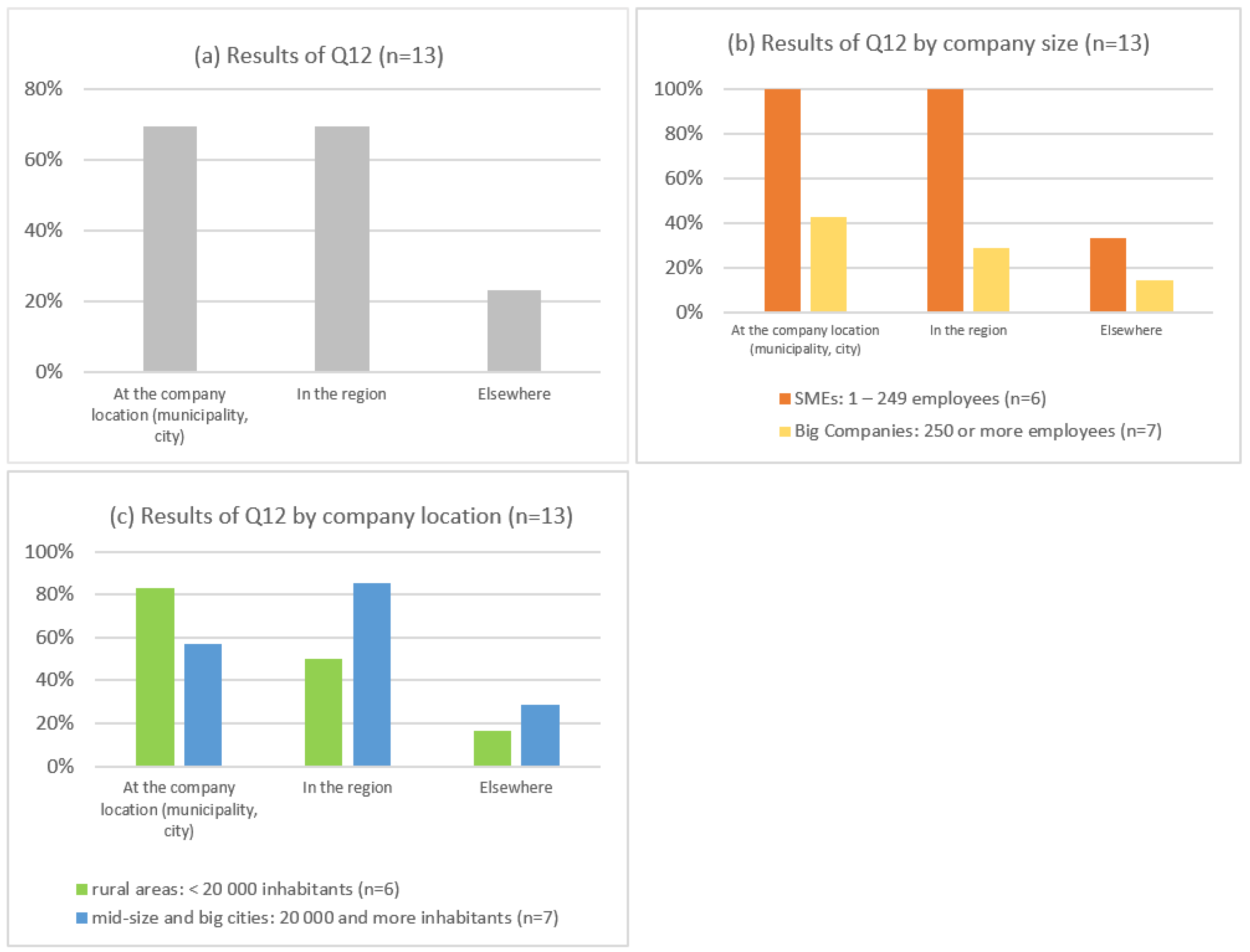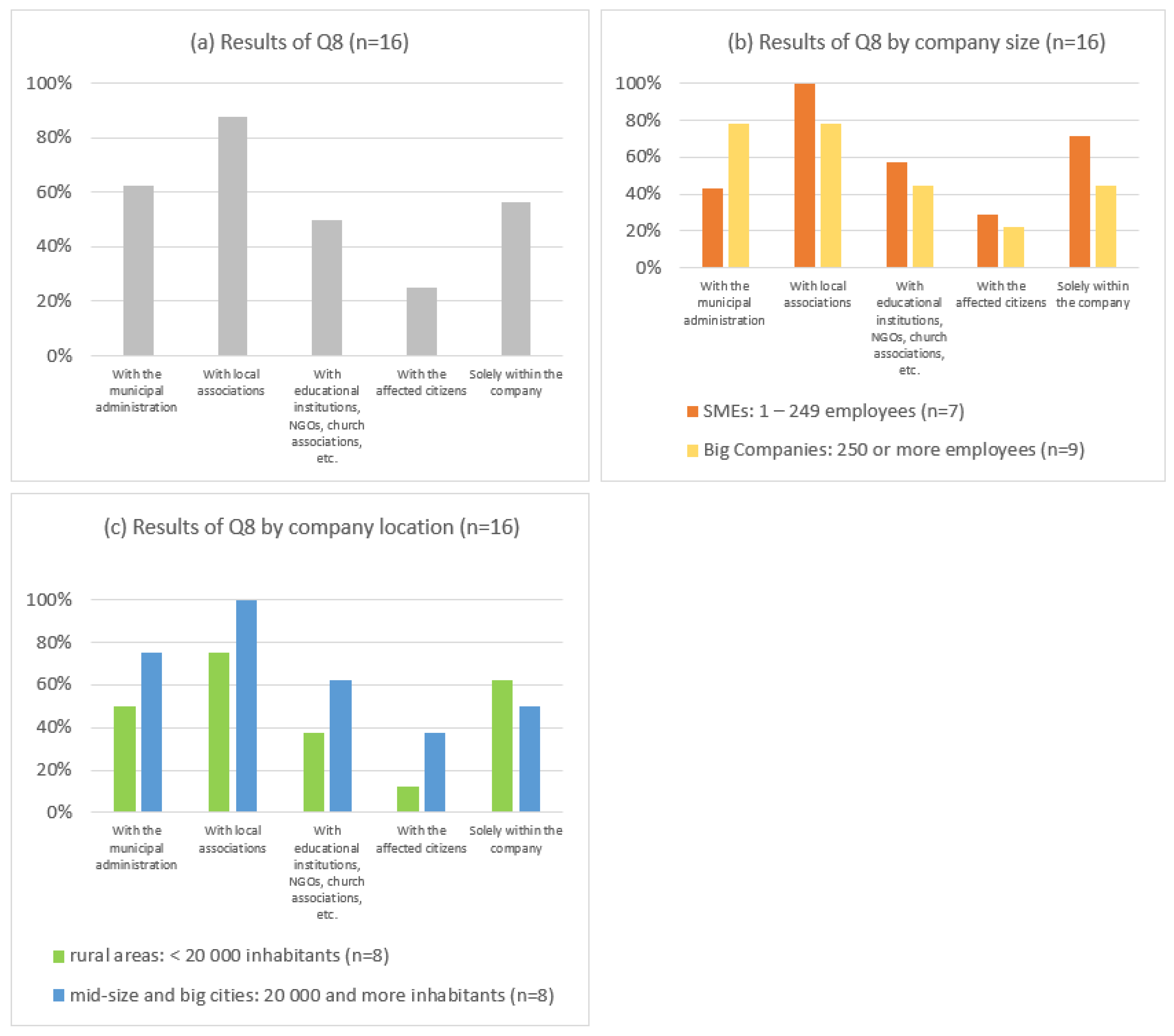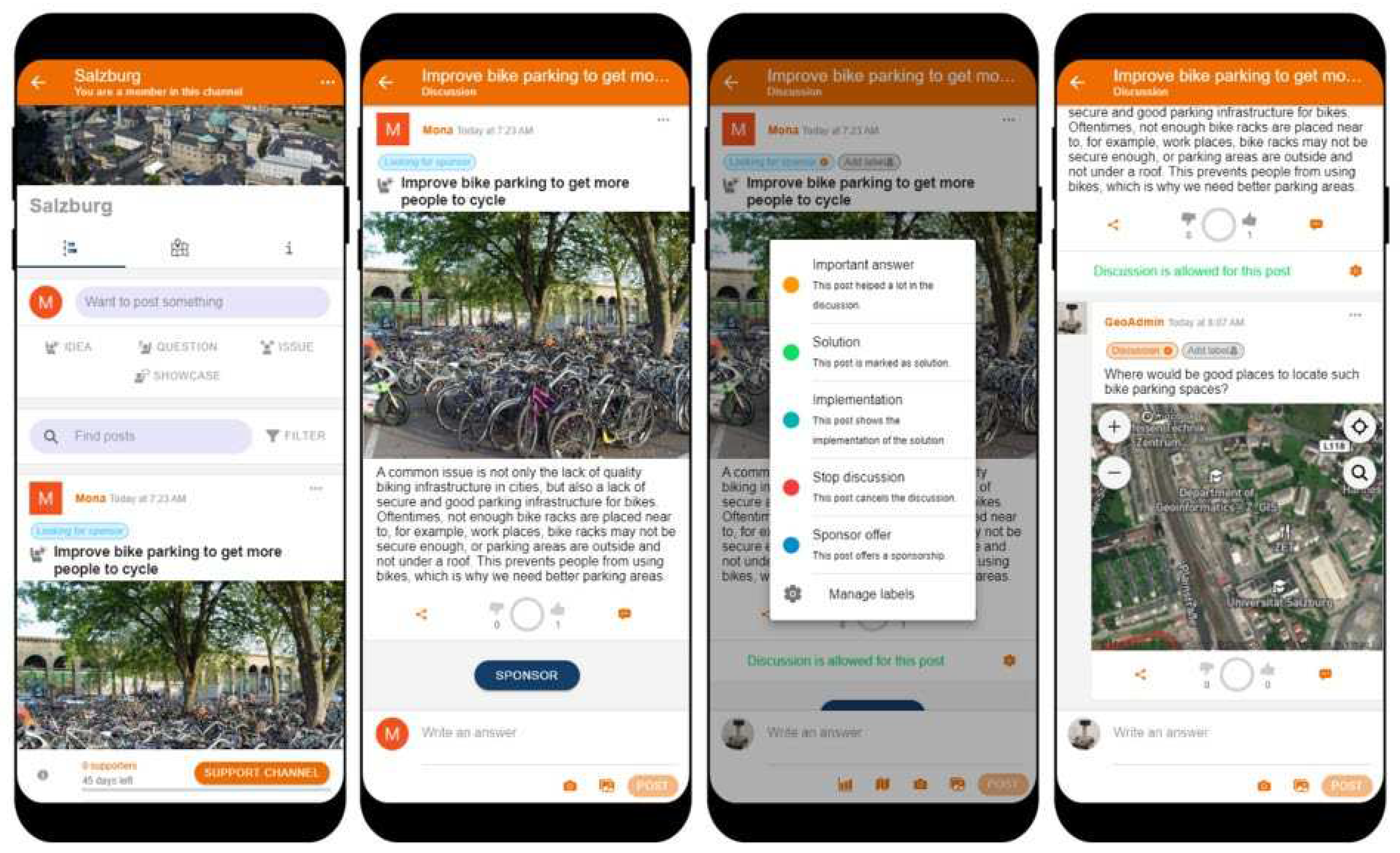Submitted:
14 November 2023
Posted:
16 November 2023
You are already at the latest version
Abstract
Keywords:
1. Introduction
2. Materials and Methods
2.1 The ‘Bürgercockpit’-Application Piloting Phase and Commercial Roll-Out
2.2 CSR-Questionnaire
2.3. P-CSR Prototype Set-Up
3. Results
3.1 Piloting Phase and Commercial Roll-Out of the ‘Bürgercockpit’-Application
3.2 CSR-Questionnaire
3.2.1. Questionnaire Part 1: Experiences and Potential of Local CSR-Initiatives





3.2.2. Questionnaire Part 2: Opportunities and Challenges


3.3. P-CSR Prototype Solution
- Local and thematic channels: CSR-initiatives in participatory community planning can be based on local, temporal and thematic components. To reflect these components also within the P-CSR prototype solution, we divided the information of CSR-practices into spatial and thematic entities (channels).
- User roles: For each of these channels, it is possible to assign different roles and authorizations to different channel users. The moderation of a channel, for example, is essential in participatory and collaborative platforms and in line with legislative requirements such as the EU GDPR (General Data Protection Regulation) and the German Network Enforcement Act. The moderator status can be assigned to a single user or a group of users who obtain extended permissions within each channel to structure discussions, communicate with external stakeholders and moderate the content (e.g., whenever the content does not comply with internet netiquette or general terms and conditions). A specific user role can be assigned to representatives of companies that want to engage in a participatory community planning process in advisory capacity (e.g., designing a community survey or moderating a discussion thread) or as sponsors.
- Participatory and spatial functionalities: A range of tools such as interactive geo-referenced surveys, polls, geospatial features and maps, as well as community-driven data collection can be integrated in channel posts and constitute key components in the discussion process on CSR-practices. These functionalities are complemented by elements such as liking, flagging, and labeling posts as well as replying to and commenting on posts. A discussion forum allows the set-up of structured processes for a collaborative development of ideas, proposals, as well as the implementation and monitoring of specific community initiatives. A set of labels enables the moderator(s) to guide the process of accepting, discussing, or rejecting ideas or initiatives (see Figure 8).
- Sponsorships: Companies can support a participatory community planning process by (a) sponsoring the design and implementation of a specific idea or initiative, or (b) assuming the license fees of a specific community channel. To prevent fraud or fraudulent behavior, companies are verified prior to becoming a supporter of a channel. In any case, these sponsoring activities are transparently listed and described in the corresponding channel(s).


4. Discussion
5. Conclusions
Supplementary Materials
Author Contributions
Funding
Data Availability Statement
Acknowledgments
Conflicts of Interest
Appendix A
References
- Latapí Agudelo, M.A.; Jóhannsdóttir, L.; Davídsdóttir, B. A literature review of the history and evolution of corporate social responsibility. Int. J. Corp. Soc. Responsib. 2019, 4. [Google Scholar] [CrossRef]
- Berger-Walliser, G.; Scott, I. Redefining Corporate Social Responsibility in an Era of Globalization and Regulatory Hardening. Am. Bus. Law J. 2018, 55, 167–218. [Google Scholar] [CrossRef]
- ElAlfy, A.; Palaschuk, N.; El-Bassiouny, D.; Wilson, J.; Weber, O. Scoping the Evolution of Corporate Social Responsibility (CSR) Research in the Sustainable Development Goals (SDGs) Era. Sustainability 2020, 12, 5544. [Google Scholar] [CrossRef]
- López-Concepción, A.; Gil-Lacruz, A.I.; Saz-Gil, I. Stakeholder engagement, CSR development and SDGs compliance: A systematic review from 2015 to 2021. Corp. Soc. Responsib. Environ. Manag. 2022, 29, 19–31. [Google Scholar] [CrossRef]
- Fallah Shayan, N.; Mohabbati-Kalejahi, N.; Alavi, S.; Zahed, M.A. Sustainable Development Goals (SDGs) as a Framework for Corporate Social Responsibility (CSR). Sustainability 2022, 14, 1222. [Google Scholar] [CrossRef]
- Agenda 21. United Nations Conference on Environment & Development 1992; United Nations Division for Sustainable Development: Rio de Janerio, Brazil, 1992.
- Schäfer, H. Green Economy, Green Deal und Sustainable Finance – Die zentrale Rolle von Nachhaltigkeitsratings. In Social Credit Rating; Springer Gabler: Wiesbaden, Germany, 2020. [Google Scholar]
- World Business Council for Sustainable Development. Definition Corporate Social Responsibility (CSR). Available online: https://www.wbcsd.org/ (accessed on 7 April 2023).
- Sattayapanich, T.; Janmaimool, P.; Chontanawat, J. Factors Affecting Community Participation in Environmental Corporate Social Responsibility Projects: Evidence from Mangrove Forest Management Project. J. Open Innov. Technol. Mark. Complex. 2022, 8, 209. [Google Scholar] [CrossRef]
- Islam, T.; Islam, R.; Pitafi, A.H.; Xiaobei, L.; Rehmani, M.; Irfan, M.; Mubarak, M.S. The impact of corporate social responsibility on customer loyalty: The mediating role of corporate reputation, customer satisfaction, and trust. Sustain. Prod. Consum. 2021, 25, 123–135. [Google Scholar] [CrossRef]
- Hopkins, M. What is corporate social responsibility all about? J. Public Aff. 2006, 6, 298–306. [Google Scholar] [CrossRef]
- Kim, H.-R.; Lee, M.; Lee, H.-T.; Kim, N.-M. Corporate Social Responsibility and Employee–Company Identification. J. Bus Ethics 2010, 95, 557–569. [Google Scholar] [CrossRef]
- Maclagan, P. Corporate social responsibility as a participative process. Bus. Ethics A Eur. Rev. 1999, 8, 43–49. [Google Scholar] [CrossRef]
- Reed, M.S.; Vella, S.; Challies, E.; Vente, J. de; Frewer, L.; Hohenwallner-Ries, D.; Huber, T.; Neumann, R.K.; Oughton, E.A.; Del Sidoli Ceno, J.; et al. A theory of participation: What makes stakeholder and public engagement in environmental management work? Restor. Ecol. 2018, 26, S7–S17. [Google Scholar] [CrossRef]
- Ghose, R. The complexities of citizen participation through collaborative governance. Space Polity 2005, 9, 61–75. [Google Scholar] [CrossRef]
- Arkorful, V.E.; Lugu, B.K.; Hammond, A.; Basiru, I. Decentralization and Citizens’ Participation in Local Governance: Does Trust and Transparency Matter? – An Empirical Study. Forum Dev. Stud. 2021, 48, 199–223. [Google Scholar] [CrossRef]
- Day, D. Citizen Participation in the Planning Process: An Essentially Contested Concept? J. Plan. Lit. 1997, 11, 421–434. [Google Scholar] [CrossRef]
- Frankish, C.J.; Kwan, B.; Ratner, P.A.; Higgins, J.W.; Larsen, C. Challenges of citizen participation in regional health authorities. Soc. Sci. Med. 2002, 54, 1471–1480. [Google Scholar] [CrossRef] [PubMed]
- Willems, J.; van den Bergh, J.; Viaene, S. Smart City Projects and Citizen Participation: The Case of London. In Public Sector Management in a Globalized World; Springer Gabler: Wiesbaden, Germany, 2017. [Google Scholar]
- Fagence, M. Citizen Participation in Planning; Elsevier Science: Burlington, MA, USA, 2014; ISBN 9781483294544. [Google Scholar]
- Ndekha, A.; Hansen, E.H.; Mølgaard, P.; Woelk, G.; Furu, P. Community participation as an interactive learning process: Experiences from a schistosomiasis control project in Zimbabwe. Acta Trop. 2003, 85, 325–338. [Google Scholar] [CrossRef]
- Project for the Development of a Community Participation Component in the Tanzanian Rural Water Supply Programme; IRC: The Hague, The Netherlands, 1981.
- Arnstein, S.R. A Ladder Of Citizen Participation. J. Am. Inst. Plan. 1969, 35, 216–224. [Google Scholar] [CrossRef]
- Smart Cities and Smart Spaces: Concepts, Methodologies, Tools, and Applications; IGI Global: Hershey, PA, USA, 2018.
- Building the Foundation for Arnstein's Ladder: Community Empowerment through a Participatory Neighborhood Narrative; Routledge Taylor & Francis Group: London, UK, 2020.
- Huxley, M. Historicizing Planning, Problematizing Participation. Int. J. Urban Reg. Res. 2013, 37, 1527–1541. [Google Scholar] [CrossRef]
- Lauria, M.; Slotterback, C.S. Learning from Arnstein's ladder: From citizen participation to public engagement; Routledge Taylor & Francis Group: New York, NY, USA, Ed.; Routledge Taylor & Francis Group: London, UK, 2021; ISBN 9781000192339. [Google Scholar]
- Karner, A.; Brower Brown, K.; Marcantonio, R.; Alcorn, L.G. The View From the Top of Arnstein’s Ladder. J. Am. Plan. Assoc. 2019, 85, 236–254. [Google Scholar] [CrossRef]
- Gaber, J. Building “A Ladder of Citizen Participation”. J. Am. Plan. Assoc. 2019, 85, 188–201. [Google Scholar] [CrossRef]
- Slack, R.E.; Corlett, S.; Morris, R. Exploring Employee Engagement with (Corporate) Social Responsibility: A Social Exchange Perspective on Organisational Participation. J. Bus. Ethics 2015, 127, 537–548. [Google Scholar] [CrossRef]
- Lewin, L.D.; Warren, D.E.; AlSuwaidi, M. Does CSR make better citizens? The influence of employee CSR programs on employee societal citizenship behavior outside of work. Bus. Soc. Rev. 2020, 125, 271–288. [Google Scholar] [CrossRef]
- Koch, C.; Bekmeier-Feuerhahn, S.; Bögel, P.M.; Adam, U. Employees’ perceived benefits from participating in CSR activities and implications for increasing employee’s engagement in CSR. Corp. Commun. Int. J. 2019, 24, 303–317. [Google Scholar] [CrossRef]
- Steurer, R. The role of governments in corporate social responsibility: Characterising public policies on CSR in Europe. Policy Sci. 2010, 43, 49–72. [Google Scholar] [CrossRef]
- Sahut, J.-M.; Peris-Ortiz, M.; Teulon, F. Corporate social responsibility and governance. J. Manag. Gov. 2019, 23, 901–912. [Google Scholar] [CrossRef]
- Zaman, R.; Jain, T.; Samara, G.; Jamali, D. Corporate Governance Meets Corporate Social Responsibility: Mapping the Interface. Bus. Soc. 2022, 61, 690–752. [Google Scholar] [CrossRef]
- Appe, S.; Barragán, D. Participatory Corporate Social Responsibility with Public Policy Impact: The Case Study of the Holcim Foundation in Ecuador. 2017. [Google Scholar]
- Agudo Valiente, J.M.; Garcés Ayerbe, C.; Salvador Figueras, M. Social responsibility practices and evaluation of corporate social performance. J. Clean. Prod. 2012, 35, 25–38. [Google Scholar] [CrossRef]
- Suwala, L.; Albers, H.-H. Corporate Spatial Responsibility and Sustainable Development Goals. In Decent Work and Economic Growth; Leal Filho, W., Azul, A.M., Brandli, L., Özuyar, P.G., Wall, T., Eds.; Springer: Cham, Switzerland, 2019; ISBN 9783319710587. [Google Scholar]
- Anser, M.K.; Yousaf, Z.; Majid, A.; Yasir, M. Does corporate social responsibility commitment and participation predict environmental and social performance? Corp Soc Responsib Env. Manag 2020, 27, 2578–2587. [Google Scholar] [CrossRef]
- Puranik, R. Participatory Approach for Corporate Social Responsibility Plan in India. In Energy and environment: Select proceedings of ICWEES-2016; Singh, V.P., Yadav, S., Yadava, R.N., Eds.; Springer: Singapore, 2017; ISBN 978-981-10-5797-7. [Google Scholar]
- Labigne, A.; Gilroy; Patrick; Kononykhina, O.; Hollman, Detlef. Christian Schilcher | Birgit Riess. In Bessere Daten für besseres Unternehmensmanagement: CC-Survey 2018: Unternehmensengagement und Corporate Citizenship in Deutschland; 2018.
- Knieling, J.; Othengrafen, F.; Preising, T. Privatisierung von Stadt- und Regionalentwicklung: Gesellschaftlicher Nutzen oder Verwirklichung von Unternehmenszielen? Corporate Spatial Responsibility” oder Corporate Spatial Strategy“? RuR 2012, 70, 451–464. [Google Scholar] [CrossRef]
- Mattila, A.S.; Hanks, L. Antecedents to participation in corporate social responsibility programs. J. Serv. Manag. 2012, 23, 664–676. [Google Scholar] [CrossRef]
- Carrera, L. Corporate social responsibility. A strategy for social and territorial sustainability. Int. J. Corp. Soc. Responsib. 2022, 7, 1–11. [Google Scholar] [CrossRef]
- Shukla, A.; Geetika; Shukla, N. Corporate Social Responsibility Measures: A Brief Review. Bus. Perspect. Res. 2022, 10, 101–120. [Google Scholar] [CrossRef]
- Sharma, E. A review of corporate social responsibility in developed and developing nations. Corp. Soc. Responsib. Environ. Manag. 2019, 26, 712–720. [Google Scholar] [CrossRef]
- Acuti, D.; Grazzini, L.; Mazzoli, V.; Aiello, G. Stakeholder engagement in green place branding: A focus on user-generated content. Corp. Soc. Responsib. Environ. Manag. 2019, 26, 492–501. [Google Scholar] [CrossRef]
- United Nations Industrial Development Organization. What is CSR? Available online:. Available online: https://www.unido.org/our-focus/advancing-economic-competitiveness/competitive-trade-capacities-and-corporate-responsibility/corporate-social-responsibility-market-integration/what-csr (accessed on 17 April 2023).
- Chen, Y.-R.R.; Hung-Baesecke, C.-J.F. Examining the Internal Aspect of Corporate Social Responsibility (CSR): Leader Behavior and Employee CSR Participation. Commun. Res. Rep. 2014, 31, 210–220. [Google Scholar] [CrossRef]
- Crane, A.; Matten, D.; McWilliams, A.; Moon, J.; Siegel, D.S. The Corporate Social Responsibility Agenda; Oxford University Press: London, UK, 2009. [Google Scholar]
- Ferramosca, S.; Verona, R. Framing the evolution of corporate social responsibility as a discipline (1973–2018): A large-scale scientometric analysis. Corp Soc Responsib. Env 2020, 27, 178–203. [Google Scholar] [CrossRef]
- Sarkar, S.; Searcy, C. Zeitgeist or chameleon? A quantitative analysis of CSR definitions. J. Clean. Prod. 2016, 135, 1423–1435. [Google Scholar] [CrossRef]
- Carroll, A.B.; Brown, J.A. Corporate Social Responsibility: A Review of Current Concepts, Research, and Issues. In Corporate social responsibility; Weber, J., Wasieleski, D.M., Eds.; Emerald Group Publishing Limited: Bingley, UK, 2018; ISBN 978-1-78754-260-0. [Google Scholar]
- Freeman, I.; Hasnaoui, A. The Meaning of Corporate Social Responsibility: The Vision of Four Nations. J Bus Ethics 2011, 100, 419–443. [Google Scholar] [CrossRef]
- Carroll, A.B. Corporate social responsibility. Organ. Dyn. 2015, 44, 87–96. [Google Scholar] [CrossRef]
- Knieling, J.; Othengrafen, F.; Preising, T. Privatisierung von Stadt- und Regionalentwicklung: Gesellschaftlicher Nutzen oder Verwirklichung von Unternehmenszielen? ‚qCorporate Spatial Responsibility” oder ‚Corporate Spatial Strategy? Raumforsch. Und Raumordn. Spat. Res. Plan. 2012, 70, 451–464. [Google Scholar] [CrossRef]
- Albers, H.-H.; Suwala, L. Räumliches Unternehmensengagement (Corporate Spatial Responsibility) und Ortsführung (Place Leadership) in Kleinstädten. Perspektiven für eine neue Ortsführung? Eine Zusammenführung von zwei Diskursen. ISR_FB 2020, 51, 62–83. [Google Scholar] [CrossRef]
- ESRI. Corporate Social Responsibility. Available online: https://www.esri.com/en-us/industries/financial/business-areas/corporate-responsibility (accessed on 21 September 2021).
- CyberSWIFT. Corporate Social Responsibility. Available online: https://www.cyber-swift.com/in/industries/corporate-social-resposibility (accessed on 21 September 2021).
- Lindgreen, A.; Swaen, V. Corporate Social Responsibility. Int. J. Manag. Rev. 2010, 12, 1–7. [Google Scholar] [CrossRef]
- Wang, Z.; Hsieh, T.-S.; Sarkis, J. CSR Performance and the Readability of CSR Reports: Too Good to be True? Corp. Soc. Responsib. Environ. Manag. 2018, 25, 66–79. [Google Scholar] [CrossRef]
- European Commission. Corporate Sustainability Reporting Directive (CSRD). Available online: https://finance.ec.europa.eu/capital-markets-union-and-financial-markets/company-reporting-and-auditing/company-reporting/corporate-sustainability-reporting_en (accessed on 7 April 2023).
- ESG. The Report. What is ESG and Why is it Important? Available online:. Available online: https://www.esgthereport.com/what-is-esg/ (accessed on 7 April 2023).
- Gillan, S.L.; Koch, A.; Starks, L.T. Firms and social responsibility: A review of ESG and CSR research in corporate finance. J. Corp. Financ. 2021, 66, 101889. [Google Scholar] [CrossRef]
- EBA. Environmental Social and Governance Disclosures. Available online: https://www.eba.europa.eu/sites/default/documents/files/document_library/Publications/Consultations/2021/Consultation%20on%20draft%20ITS%20on%20Pillar%20disclosures%20on%20ESG%20risk/963626/Factsheet%20-%20ESG%20disclosures.pdf (accessed on 17 April 2023).
- Li, T.-T.; Wang, K.; Sueyoshi, T.; Wang, D.D. ESG: Research Progress and Future Prospects. Sustainability 2021, 13, 11663. [Google Scholar] [CrossRef]
- Atzmanstorfer, K.; Eitzinger, A.; Marin, B.E.; Parra Arteaga, A.; Gonzalez Quintero, B.; Resl, R. HCI-Evaluation of the GeoCitizen-reporting App for citizen participation in spatial planning and community management among members of marginalized communities in Cali, Colombia. giforum 2016, 4, 117–132. [Google Scholar] [CrossRef]
- Atzmanstorfer, K.; Resl, R.; Eitzinger, A.; Izurieta, X. The GeoCitizen-approach: Community-based spatial planning - an Ecuadorian case study. Cartogr. Geogr. Inf. Sci. 2014, 41, 248–259. [Google Scholar] [CrossRef] [PubMed]
- Bartling, M.; Resch, B.; Eitzinger, A.; Zurita-Arthos, L. A Multi-National Human–Computer Interaction Evaluation of the Public Participatory GIS GeoCitizen. giforum 2019, 1, 19–39. [Google Scholar] [CrossRef]
- Bartling, M.; Resch, B.; Trösterer, S.; Eitzinger, A. Evaluating PPGIS Usability in a Multi-National Field Study Combining Qualitative Surveys and Eye-Tracking. Cartogr. J. 2021, 58, 167–182. [Google Scholar] [CrossRef]
- Atzmanstorfer, K.; Blaschke, T. The Geospatial Web. In Citizen e-participation in urban governance: Crowdsourcing and collaborative creativity; Silva, C.N., Ed.; Information Science Reference an imprint of IGI Global: Hershey, PA, USA, 2013; pp. 144–171. ISBN 9781466641693. [Google Scholar]
- Waugaman, A. From principle to practice: Implementing the principles for digital development. In Proceedings of the Principles for Digital Development Working Group No. 4, Washington, DC, USA; 2016. [Google Scholar]
- Eitzinger, A.; Cock, J.; Atzmanstorfer, K.; Binder, C.R.; Läderach, P.; Bonilla-Findji, O.; Bartling, M.; Mwongera, C.; Zurita, L.; Jarvis, A. GeoFarmer: A monitoring and feedback system for agricultural development projects. Comput. Electron. Agric. 2019, 158, 109–121. [Google Scholar] [CrossRef]
- Eitzinger, A.; Bartling, M.; Bonilla-Findji, O.; Andrieu, N.; Jarvis, A.; Feil, C. GeoFarmer App - A tool to complement extension services and foster active farmers' participation and knowledge exchange . 2020. [Google Scholar]
- Bartling, M.; Robinson, A.C.; Resch, B.; Eitzinger, A.; Atzmanstorfer, K. The role of user context in the design of mobile map applications. Cartogr. Geogr. Inf. Sci. 2021, 48, 432–448. [Google Scholar] [CrossRef] [PubMed]
- Pavlish, C.P.; Pharris, M.D. Community-based collaborative action research: A nursing approach; Jones & Bartlett Learning: Sudbury, MA, USA, 2012; ISBN 9780763771126. [Google Scholar]
- Ledwith, M.; Springett, J. Participatory practice: Community-based action for transformative change, 2nd ed.; Policy Press: Bristol, UK, 2022; ISBN 9781447360070. [Google Scholar]
- Wissenschaftlicher Beirat der Bundesregierung Globale Umweltveränderungen. In World in transition: A social contract for sustainability with 62 figures; WBGU: Berlin, Germany, 2011; ISBN 9783936191370.
- European Commission Recommendation of 6 May 2003 concerning the definition of micro, small and medium-sized enterprises . 6 May 2003.
- ÖROK. 16. Raumordnungsbericht: Analysen und Berichte zur räumlichen Entwicklung Österreichs 2018 - 2020 No. 209. 2020. [Google Scholar]
- European Union. Community-Led Local Development (CLLD). Available online: https://enrd.ec.europa.eu/leader-clld_en (accessed on 27 December 2022).
| Company Size | Number of Participants |
| 1 – 5 employees | 2 |
| 6 - 10 employees | 4 |
| 11- 50 employees | 8 |
| 51 - 249 employees | 4 |
| 250 or more employees | 11 |
| Company Locations | Number of Participants |
| Rural municipality (< 5000 inhabitants) | 6 |
| Small town (5000 – 19 999 inhabitants) | 8 |
| Medium town (20000 – 99 999 inhabitants) | 2 |
| Big city (100 000 or more inhabitants) | 13 |
Disclaimer/Publisher’s Note: The statements, opinions and data contained in all publications are solely those of the individual author(s) and contributor(s) and not of MDPI and/or the editor(s). MDPI and/or the editor(s) disclaim responsibility for any injury to people or property resulting from any ideas, methods, instructions or products referred to in the content. |
© 2023 by the authors. Licensee MDPI, Basel, Switzerland. This article is an open access article distributed under the terms and conditions of the Creative Commons Attribution (CC BY) license (http://creativecommons.org/licenses/by/4.0/).




